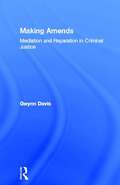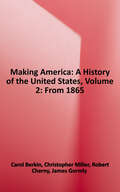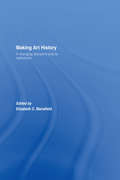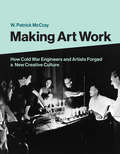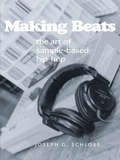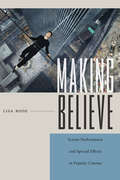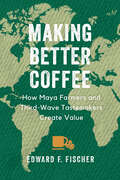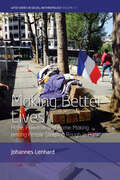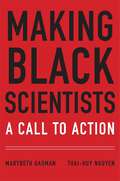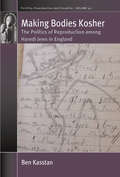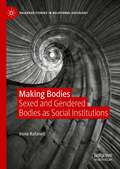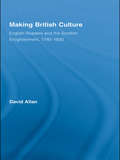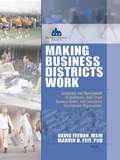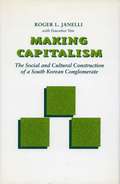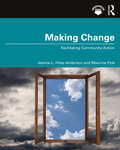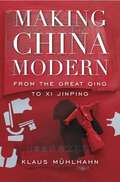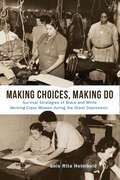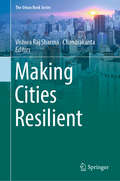- Table View
- List View
Making Amends: Mediation and Reparation in Criminal Justice
by Gwynn DavisReparation, or making amends, is an ancient theme in criminal justice. It was revived in both Europe and North America in the 1980s as a practical alternative both to retributivism, and to the various utilitarian projects traditionally associated with retributive justice.Making Amends examines the practice of these schemes in the UK, USA, and Germany, and shows how criminal justice institutions were unresponsive to these attempts to cast justice in a new form. Yet the experiments reflected an abiding dissatisfaction with criminal courts and with the manner in which justice is conceived and expressed within the criminal framework. The authors' conclusions therefore have implications for the workings of the criminal justice system as a whole.
Making America: A History of the United States, 6e, Vol. 2: Since 1865
by Carol Berkin Christopher Miller Robert Cherny James GormlyShaped with a clear political chronology, Making America reflects the variety of individual experiences and cultures that comprise American society. Making America provides a clear, helpful text with a strongly chronological narrative and an integrated program of learning aids that make the historical content vivid and comprehensible to readers at all levels of preparedness.
Making Anti-Racial Discrimination Law: A Comparative History of Social Action and Anti-Racial Discrimination Law
by Iyiola SolankeMaking Anti-Racial Discrimination Law examines the evolution of anti-racial discrimination law from a socio-legal perspective. Taking a comparative and interdisciplinary approach, the book does not simply look at race and society or race and law but brings these areas together by drawing out the tension in the process, in different countries, by which race becomes a policy issue which is subsequently regulated by law. Moving beyond traditional social movement theory to include the extreme right wing as a social actor, the study identifies the role of extreme right wing confrontation in agenda setting and law-making, a feature often neglected in studies of social action. In so doing, it identifies the influence of both the extreme right and liberalism on anti-racial discrimination law. Focusing primarily on Great Britain and Germany, the book also demonstrates how national politics feeds into EU policy and identifies some of the challenges in creating a high and uniform level of protection against racial discrimination throughout the EU. Using primary archival materials from Germany and the UK, the empirical richness of this book constitutes a valuable contribution to the field of anti-racial discrimination law, at both undergraduate and postgraduate level. The book will interest specialists and academics in law, sociology and political science as well as non-specialists, who will find this study stimulating and useful to expand their knowledge of anti-racial discrimination law or pursue teaching goals, policy objectives and reform agendas.
Making Archaeology Happen: Design versus Dogma
by Martin Oswald Carver‘Archaeology is for people’ is the theme of this book. Split between the academic and commercial sectors, archaeological investigation is also deeply embedded in the needs of local communities, making it simultaneously an art, science and social science. Such a multi-disciplinary discipline needs special methods and creative freedom, not repetitive responses. Carver argues that commercial procedures and academic theory are both suffocating creativity in fieldwork. He’d like to see us bring much more diversity and technical ingenuity to every opportunity, and maintains this is more a matter of getting ourselves free of dogma than needing more time and money. This has many implications for the way archaeology is designed and procured – moving archaeologists up the professional ladder from builder to architect, with contracts based on quality of design, not the price.
Making Art History: A Changing Discipline and its Institutions
by Elizabeth C. MansfieldMaking Art History is a collection of essays by contemporary scholars on the practice and theory of art history as it responds to institutions as diverse as art galleries and museums, publishing houses and universities, school boards and professional organizations, political parties and multinational corporations. The text is split into four thematic sections, each of which begins with a short introduction from the editor, the sections include: Border Patrols, addresses the artistic canon and its relationship to the ongoing 'war on terror', globalization, and the rise of the Belgian nationalist party. The Subjects of Art History, questions whether 'art' and 'history' are really what the discipline seeks to understand. Instituting Art History, concerns art history and its relation to the university and raises questions about the mission, habits, ethics and limits of university today. Old Master, New Institutions, shows how art history and the museum respond to nationalism, corporate management models and the 'culture wars'.
Making Art Work: How Cold War Engineers and Artists Forged a New Creative Culture
by W. Patrick MccrayThe creative collaborations of engineers, artists, scientists, and curators over the past fifty years.Artwork as opposed to experiment? Engineer versus artist? We often see two different cultural realms separated by impervious walls. But some fifty years ago, the borders between technology and art began to be breached. In this book, W. Patrick McCray shows how in this era, artists eagerly collaborated with engineers and scientists to explore new technologies and create visually and sonically compelling multimedia works. This art emerged from corporate laboratories, artists' studios, publishing houses, art galleries, and university campuses. Many of the biggest stars of the art world--Robert Rauschenberg, Yvonne Rainer, Andy Warhol, Carolee Schneemann, and John Cage--participated, but the technologists who contributed essential expertise and aesthetic input often went unrecognized.
Making Beats
by Joseph G. SchlossDespite having created one of the most important musical cultures of the last fifty years, hip-hop composers who use digital sampling are rarely taken seriously as artists. But hip-hop deejays and producers have collectively developed an artistic system that features a complex aesthetic, a detailed array of social protocols, a rigorous set of ethical expectations and a rich historical consciousness. Based on ten years of research among hip-hop producers, Making Beats is the first work of scholarship to explore the goals, methods and values of this surprisingly insular community. Focusing on a variety of subjects--from hip-hop artists' pedagogical methods to the Afro-diasporic roots of the sampling process to the social significance of "digging" for rare records--Joseph G. Schloss examines the way hip-hop artists have managed to create a form of expression that reflects their creative aspirations, moral beliefs, political values and cultural realities.
Making Believe: Screen Performance and Special Effects in Popular Cinema
by Lisa BodeIn the past twenty years, we have seen the rise of digital effects cinema in which the human performer is entangled with animation, collaged with other performers, or inserted into perilous or fantastic situations and scenery. Making Believe sheds new light on these developments by historicizing screen performance within the context of visual and special effects cinema and technological change in Hollywood filmmaking, through the silent, early sound, and current digital eras. Making Believe incorporates North American film reviews and editorials, actor and crew interviews, trade and fan magazine commentary, actor training manuals, and film production publicity materials to discuss the shifts in screen acting practice and philosophy around transfiguring makeup, doubles, motion capture, and acting to absent places or characters. Along the way it considers how performers and visual and special effects crew work together, and struggle with the industry, critics, and each other to define the aesthetic value of their work, in an industrial system of technological reproduction. Bode opens our eyes to the performing illusions we love and the tensions we experience in wanting to believe in spite of our knowledge that it is all make believe in the end.
Making Better Coffee: How Maya Farmers and Third Wave Tastemakers Create Value
by Edward F. FischerAn anthropologist uncovers how "great coffee" depends not just on taste, but also on a complex system of values worked out among farmers, roasters, and consumers. What justifies the steep prices commanded by small-batch, high-end Third Wave coffees? Making Better Coffee explores this question, looking at highland coffee farmers in Guatemala and their relationship to the trends that dictate what makes "great coffee." Traders stress material conditions of terroir and botany, but just as important are the social, moral, and political values that farmers, roasters, and consumers attach to the beans. In the late nineteenth century, Maya farmers were forced to work on the large plantations that colonized their ancestral lands. The international coffee market shifted in the 1990s, creating demand for high-altitude varietals—plants suited to the mountains where the Maya had been displaced. Edward F. Fischer connects the quest for quality among U.S. tastemakers to the lives and desires of Maya producers, showing how profits are made by artfully combining coffee's material and symbolic attributes. The result is a complex story of terroir and taste, quality and craft, justice and necessity, worth and value.
Making Better Lives: Hope, Freedom and Home-Making among People Sleeping Rough in Paris (WYSE Series in Social Anthropology #11)
by Johannes LenhardIn this ethnographic study, Johannes Lenhard observes the daily practices, routines and techniques of people who are sleeping rough on the streets of Paris. The book focusses on their survival practises, their short-term desires and hopes, how they earn money through begging, how they choose the best place to sleep at night and what role drugs and alcohol play in their lives. The book also follows people through different institutional settings, including a homeless day centre, a needle exchange, a centre for people with alcohol problems and a homeless shelter.
Making Better Lives: Hope, Freedom and Home-Making among People Sleeping Rough in Paris (WYSE Series in Social Anthropology #11)
by Johannes LenhardIn this ethnographic study, Johannes Lenhard observes the daily practices, routines and techniques of people who are sleeping rough on the streets of Paris. The book focusses on their survival practises, their short-term desires and hopes, how they earn money through begging, how they choose the best place to sleep at night and what role drugs and alcohol play in their lives. The book also follows people through different institutional settings, including a homeless day centre, a needle exchange, a centre for people with alcohol problems and a homeless shelter.
Making Black Scientists: A Call to Action
by Marybeth Gasman Thai-Huy NguyenHistorically black colleges and universities are adept at training scientists. Marybeth Gasman and Thai-Huy Nguyen follow ten HBCU programs that have grown their student cohorts and improved performance. These science departments furnish a bold new model for other colleges that want to better serve African American students.
Making Bodies Kosher: The Politics of Reproduction among Haredi Jews in England (Fertility, Reproduction and Sexuality: Social and Cultural Perspectives #42)
by Ben KasstanFor Haredi Jews, reproduction is entangled with issues of health, bodily governance and identity. This is an analysis of the ways in which Haredi Jews negotiate healthcare services using theoretical perspectives in political philosophy. This is the first archival and ethnographic study of Haredi Jews in the UK and sits at the intersection of medical anthropology, social history and Jewish studies. It will allow readers to understand how reproductive care issues affect this growing minority population.
Making Bodies: Sexed and Gendered Bodies as Social Institutions (Palgrave Studies in Relational Sociology)
by Irene RafanellThis book presents a novel theoretical account of the claim that sexed and gendered bodies are socially constructed. In order to do so it critically reconstructs and combines existing theories of the embodiment of social identity (Bourdieu, Foucault, Butler) with the constructionist account of the Sociology of Knowledge (Strong Programme). This allows the author to develop a detailed conceptual apparatus which helps to analyse the nature of sexed and gendered bodies as social institutions. This book argues for a view of the body as an ‘artificial kind’ of entity which is the effect of contingent and localized practices and that incorporates both social and natural determinants. In doing so, the book reformulates key sociological dichotomies such as nature/society; structure/agency and domination/resistance, critically analysing different structuralist positions and advancing an ‘intrinsic’ structuralist model which foregrounds the importance of human relations in the constitution of social phenomena. This theoretical investigation has important methodological implications for empirical research into the formation of sex and gender identities and practices, enabling a more objective and naturalistic approach to empirical data concerning social phenomena.
Making British Culture: English Readers and the Scottish Enlightenment, 1740–1830 (Routledge Studies in Cultural History)
by David AllanMaking British Culture explores an under-appreciated factor in the emergence of a recognisably British culture. Specifically, it examines the experiences of English readers between around 1707 and 1830 as they grappled, in a variety of circumstances, with the great effusion of Scottish authorship – including the hard-edged intellectual achievements of David Hume, Adam Smith and William Robertson as well as the more accessible contributions of poets like Robert Burns and Walter Scott – that distinguished the age of the Enlightenment.
Making Business Districts Work: Leadership and Management of Downtown, Main Street, Business District, and Community Development Org
by Marvin D Feit David FeehanUnprecedented, broad coverage of downtown and community development topics from a practitioner&’s viewpoint!Making Business Districts Work: Leadership and Management of Downtown, Main Street, Business District, and Community Development Organizations is the essential desk reference for downtown and community business district profe
Making Canada New: Editing, Modernism, and New Media
by Dean Irvine Bart A. Vautour Vanessa LentAn examination of the connections between modernist writers and editorial activities, Making Canada New draws links among new and old media, collaborative labour, emergent scholars and scholarships, and digital modernisms. In doing so, the collection reveals that renovating modernisms does not need to depend on the fabrication of completely new modes of scholarship. Rather, it is the repurposing of already existing practices and combining them with others – whether old or new, print or digital – that instigates a process of continuous renewal. Critical to this process of renewal is the intermingling of print and digital research methods and the coordination of more popular modes of literary scholarship with less frequented ones, such as bibliography, textual studies, and editing. Making Canada New tracks the editorial renovation of modernism as a digital phenomenon while speaking to the continued production of print editions.
Making Capitalism: The Social and Cultural Construction of a South Korean Conglomerate
by Roger L. Janelli Dawnhee YimThis pathbreaking work extends the boundaries of contemporary anthropological research by presenting in one cohesive, meticulously researched work: an original theoretical perspective on the relationships between the cultural, political, and economic dimensions of a large modern business organization; the first anthropological work on South Korean management and its white-collar workers, in a case study of one of South Korea's "big four" conglomerates; and an innovative delineation of how modern business practices are enmeshed in past and present, structure and agency, and local and international systems." "Based largely on the author's nine months of participant-observation in the offices of one of South Korea's largest conglomerates (with annual sales of about $15 billion and approximately 80,000 employees), the book is also enriched by the author's previous fieldwork in rural Korea, where many of the conglomerate's white-collar personnel spent their formative years. These vantage points are used to explore constructions of "traditional" Korean culture and transformations of cultural knowledge prompted by new political-economic conditions, and how both inform practices prevailing in the large conglomerates - and ultimately shape South Korea's capitalism." "The work focuses on South Korea's new middle class. It explains how office workers' identities and often contradictory interests present them with choices between alternative interpretations and actions affecting both themselves and their conglomerates. Much attention is paid to ideological and more coercive means of controlling white-collar employees, to subordinates' strategies of resistance, and to ways in which cultural understandings and moral claims inform the assessment and pursuit of material advantage.
Making Change: Facilitating Community Action
by Jeanne L Hites Anderson Maurine H PyleEvery community has issues or opportunities that need to be addressed. The expert knowledge of community members could be the key to creating lasting change. By making community members into facilitators, Making Change: Facilitating Community Action suggests they can guide community members through the process of making change and to help them determine their goals and methods. The aim of this book is to enable facilitators to identify concerns and address, enable and foster change at the local level through effective facilitation. This book follows a six-stage model for creating change. Beginning with issue awareness, it continues through getting to know the team they are working with, seeking information on the issue and community, through facilitating the planning and community development through evaluation. This book focuses on the human side of the change process while also teaching the practical skills necessary for individuals to reach their goal. Making Change is for people interested in making change to improve their community, including students, community activists, local government and educational leaders.
Making Chaplaincy Work: Practical Approaches
by Laurel A BurtonWith compassion and commitment, practicing chaplains draw on a wide range of professional experiences and discuss principles, themes, and guidelines that have enhanced their ministries. These practical and successful approaches are aimed at helping others face the daily professional challenges of health care chaplaincy. The issues and responsibilities of chaplaincy work with a variety of patient populations--AIDS sufferers, long-term care patients, stroke victims, and the terminally ill--are thoroughly explored. Contributors provide creative and innovative methods of meeting the needs of hospital patients and their families as well as health care personnel, such as implementing a volunteer clergy program and establishing a surgical reporting plan.
Making China Modern: From the Great Qing to Xi Jinping
by Klaus MühlhahnKlaus Mühlhahn situates modern China in the nation’s long, dynamic tradition of overcoming adversity and weakness through creative adaptation—a legacy of crisis and recovery that is apparent today in China’s triumphs but also in its most worrisome trends. Mühlhahn’s panoramic survey rewrites the history of modern China for a new generation.
Making Choices, Making Do: Survival Strategies of Black and White Working-Class Women during the Great Depression
by Lois Rita HelmboldMaking Choices, Making Do is a comparative study of Black and white working-class women’s survival strategies during the Great Depression. Based on analysis of employment histories and Depression-era interviews of 1,340 women in Chicago, Cleveland, Philadelphia, and South Bend and letters from domestic workers, Lois Helmbold discovered that Black women lost work more rapidly and in greater proportions. The benefits that white women accrued because of structural racism meant they avoided the utter destitution that more commonly swallowed their Black peers. When let go from a job, a white woman was more successful in securing a less desirable job, while Black women, especially older Black women, were pushed out of the labor force entirely. Helmbold found that working-class women practiced the same strategies, but institutionalized racism in employment, housing, and relief assured that Black women worked harder, but fared worse. Making Choices, Making Do strives to fill the gap in the labor history of women, both Black and white. The book will challenge the limits of segregated histories and encourage more comparative analyses.
Making Christ Present in China: Actor-Network Theory and the Anthropology of Christianity
by Michel ChambonAn anthropological theorization of the unity and diversity of Christianity, this book focuses on Christian communities in Nanping, a small city in China. It applies methodological insights from Actor-Network Theory to investigate how the Christian God is made part of local social networks. The study examines how Christians interact with and re-define material objects, such as buildings, pews, offerings, and blood, in order to identify the kind of networks and non-human actors that they collectively design. By comparing local Christian traditions with other practices informing the Nanping religious landscape, the study points out potential cohesion via the centralizing presence of the Christian God, the governing nature of the pastoral clergy, and the semi-transcendent being of the Church.
Making Cities Resilient (The Urban Book Series)
by Chandrakanta Vishwa Raj SharmaAs the world has transformed, so have cities. Today, cities are home to 54 percent of the world’s population, and by the middle of this century that figure will likely rise to 66 percent. According to the United Nations (UN) Habitat I (1972), Habitat II (1996) and Habitat III (2016) summits, cities are facing many serious challenges, including growing inequality, security concerns and the worsening impacts of climate change. Uncontrolled urbanization has led to many problems (haphazard growth of areas, emergence of slums, inadequate water and power supply, poor sanitation, shortage of transport and other civic amenities, shrinking green spaces, pollution, crime, and urban disaster risks such as fire, flood, road and industrial accidents, etc.). Worldwide, communities at the international, national and local level are continuously working to improve human habitats. In order to make our planet more sustainable, the UN has moved from the Millennium Development Goals (MDG) to the Sustainable Development Goals (SDG). Among the latter, the aim of SDG 11 is to “…make cities and human settlements inclusive, safe, resilient and sustainable.” In light of these challenges, various terms have emerged to help understand urban issues. Visualizing the problem, the United Nations program “Making Cities Resilient” is focused on mitigating the disaster risk in urban areas. This book analyzes terms such as: sustainable, resilient, livable, inclusive, smart and world class city, which have emerged in the process of combating urban challenges in today’s world. The book addresses emerging concepts for cities, challenges and potentials, urban environments, health and planning/policies. Covering 14 large cities in India, as well as case studies from Japan, Singapore, Thailand, Malaysia, Poland and Sweden, it provides a regional dimension to and micro-level perspective on urban issues.
Making Cities Work: The Dynamics Of Urban Innovation
by David Morley Thomas Burns Stuart ProudfootThis book is an outcome of the conference 'Urban Innovation: Working Solutions to the Problems of Human Settlement' held in 1977. It focuses on urban innovations as working alternatives that reflect an institutional capacity to adapt complex human systems in response to basic environmental change.
